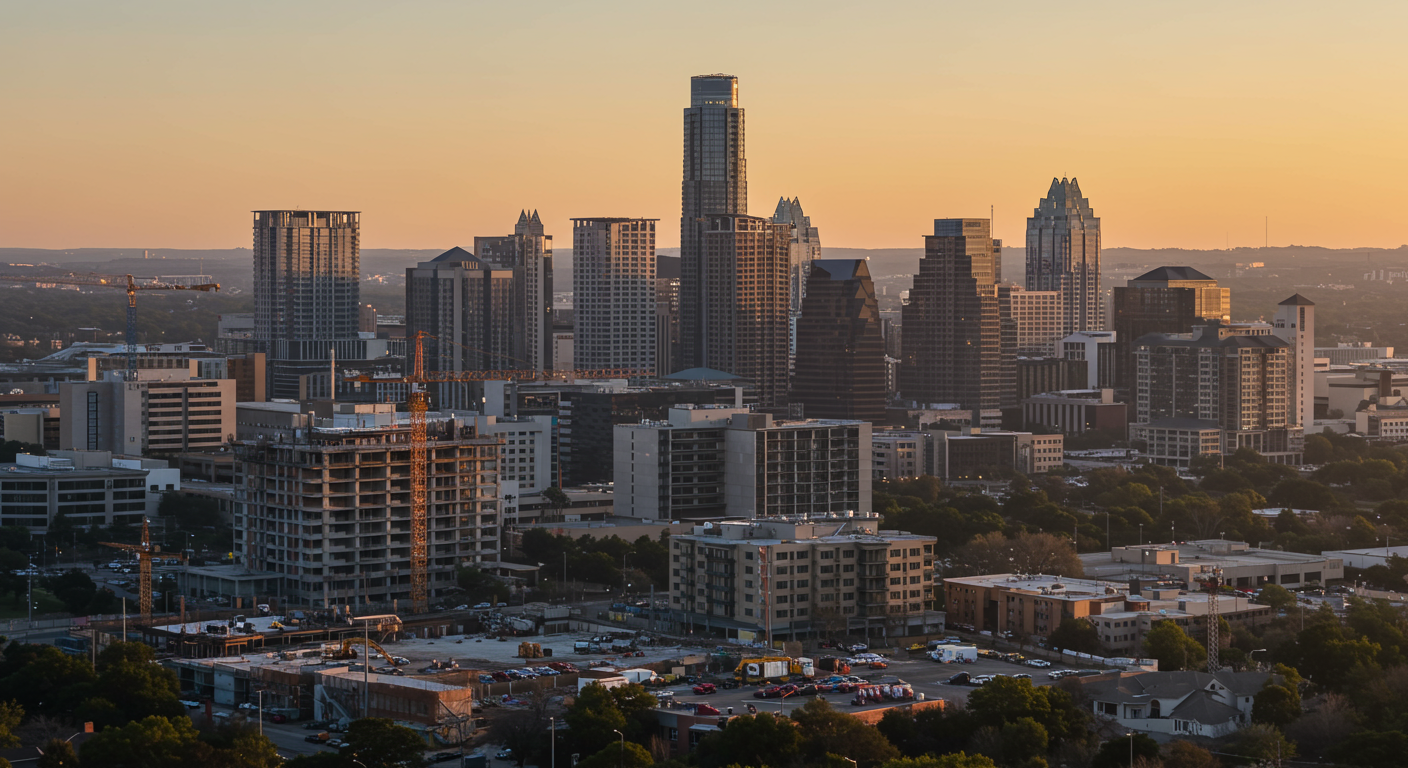Insights
- Austin is the 14th best performing among the top 50 metros, adding 32,800 jobs, 2.5% growth, in the year ending in December.
- The fastest job growth over the last 12 months occurred in Austin’s construction and natural resources (10.5%) and education and healthcare (5.9%) industries.
- Austin’s seasonally adjusted unemployment rate increased to 3.6% in December from 3.5% in November.
Nonfarm payroll jobs
Austin’s December nonfarm payroll jobs total is up by 32,800, or 2.5%, over the last 12 months according to this week’s releases of monthly labor market data by the Texas Workforce Commission and the U.S. Bureau of Labor Statistics. On a seasonally adjusted basis, Austin jobs increased by 500 or 0.04% from November to December.

Austin’s year-over-year increase of 2.5% makes it the 14th best performing among the 50 largest metro areas. Faster growing Dallas (3.3%), San Antonio (3.2%), and Fort Worth (2.8%) place in the top 10, while Houston (2.1%) ranks 19th.

For the year ending in December, private sector job growth in the Austin MSA is 2.4%, or 27,200 jobs, with gains across nine of the 11 major private industry sectors. Customarily, slower job creation in the government sector drives overall job growth lower than private sector job growth in Austin. That has not been the case over the last four months. Government year-over-year job growth is uncommonly strong in December (3.0% or 5,600 jobs).

Texas saw net private sector job growth of 2.9% with each of the private industry groups adding jobs over the last 12 months. Total job growth was also 2.9% as the government sector grew at a comparable 2.8% rate. For the nation, private sector job growth was 1.6% for the 12 months ending in December with all but two private industries adding jobs. Overall job growth was slightly higher at 1.9%, due to robust 3.1% government sector growth.

Jobs in December are down by 2,000 or 0.1% from November in the not-seasonally-adjusted series for Austin. However, the seasonally adjusted series shows jobs essentially unchanged—with a gain of 500 jobs or 0.04%. Seasonally adjusted jobs are up in San Antonio (0.5%), Fort Worth (0.1%), and Houston (0.1%), but down in Dallas (0.1%). Statewide, seasonally adjusted jobs are up by 19,100 or 0.1%. Nationally, seasonally adjusted jobs are up from November by 216,000 or 0.1%.

In Austin, nine of the 11 major private industry sectors added jobs over the last 12 months. Construction and natural resources is the fastest growing (10.5% or 8,100 jobs) and education and health services (5.9% or 8,600) added the most jobs. The large professional and business services industry (up 5,300) is commonly the industry adding the most jobs and one of the fastest growing in Austin, but over the last year, that’s not the case, and the industry’s 1.9% rate of growth is slower than private industry overall. Wholesale trade (-5.6% or -3,300 jobs) and information (-3.0% or -1,600) saw negative year-over-year growth.

Statewide, over the last 12 months, all private industries added jobs. The industries with the most significant growth, like Austin, are also construction and natural resources (5.2%) and education and health services (4.3%).
Nationally, all private industries except two, added jobs over the 12 months ending in December, led by education and health services (up 4.3%) and leisure and hospitality (3.2%). Information (-2.2%) and transportation, warehousing and utilities (-0.4%) lost jobs.

Over the last 12 months, the net gain for private service-providing industries in Austin is 19,000 jobs, or 2.0%. Employment in goods-producing industries is up by 8,200 jobs or 5.5%. Statewide, private service-providing industries are up 264,700 or 2.7%, and goods-producing industries are up 76,900 or 3.9%.
Additional graphs: New/lost jobs by industry for Nov. 2023-Dec. 2023 and the trend since 2000 for six large industries and six small industries.
Labor force, employment & unemployment
We also now have November labor force, employment, and unemployment numbers for Texas and local areas in Texas. The same data for all U.S. metros will not be released by the U.S. Bureau of Labor Statistics until February 6. In November, Austin had the 17th lowest rate of unemployment among the 50 largest metros. Unemployment numbers for December show Austin’s performance relative to the state and other major Texas metros being sustained.

In December, Austin’s not-seasonally-adjusted unemployment rate is 3.0%, which is an increase of 0.4 percentage points above where it was one year ago (2.6%). Rates in the other major Texas metros range from 3.1% in San Antonio to 3.8% in Houston. Houston is unchanged and San Antonio’s rate is 0.1 percentage points below last year. Fort Worth’s and Dallas’ current rates are 0.1 to 0.2 percentage points below the rates one year ago. The statewide rate is now 3.5%, unchanged from December of last year. The national unemployment rate is also 3.5%, up from 3.3% a year ago.

December unemployment rates are 2.9% in Bastrop, Hays, and Travis Counties, and 3.1% in Caldwell and Williamson Counties.
On a seasonally adjusted basis, Austin’s December unemployment rate is 3.6%, up from 3.5% in November. The statewide rate is 4.0%, down from 4.1% in November. The national rate is 3.7%, unchanged from November.
Among Texas’ other major metros, Fort Worth and San Antonio are at 3.8%, Dallas is at 3.9%, and Houston is at 4.4%. Seasonally adjusted unemployment rates for Texas metros are produced by the Federal Reserve Bank of Dallas. (The Texas Workforce Commission also produces seasonally adjusted rates for Texas metros, but publication lags the Dallas Fed’s estimates.)

With Austin’s unemployment rate up from one year ago, the number unemployed has also risen. In December 2022, Austin’s number of unemployed was 37,225. Over the last 12 months, the unemployed increased by 5,953 or 16.0%, to 43,178. This is due to a larger increase in the labor force, compared to the number employed. The Austin metro’s civilian labor force (employed plus unemployed) increased by 42,224 persons or 3.0% from one year ago, while persons employed increased by 36,271 or 2.6%.

Additional graphs – Labor force & employment: Texas and United States
Texas’ labor force growth (373,896 or 2.5%) over the last 12 months is greater than the growth in the number employed (358,584 or 2.5%). Thus, the number of unemployed increased by 15,312 or 3.0%. Nationally, December civilian labor force is up by 2.4 million or 1.5%, while the number of employed is above the level of a year ago by 1.9 million or 1.2%, and 555,000 more people (10.4%) are unemployed.


Conclusion
Recent months have seen Austin’s and Texas’ job growth slow. Austin’s year-over-year job growth averaged 2.8% in the second half of 2023, following an average of 4.8% in the first half of the year. Nevertheless, Austin achieved stronger growth than all but 13 of the 50 largest metros for the 12 months ending in December. For Texas, growth averages are 3.0% for the last six months, following 4.3% in the preceding six months. Year-over-year growth slowed to an average of 1.9% nationally over the last half of 2023, after averaging 2.8% in the first half.
Austin’s seasonally adjusted unemployment rate increased to 3.6% in December from 3.5% in November. Texas’ rate ticked down from 4.1% to 4.0% and the national rate held steady at 3.7%. While the number of unemployed in Austin is higher than it was a year ago, December’s total unemployed is lower than in any other month of 2023.





